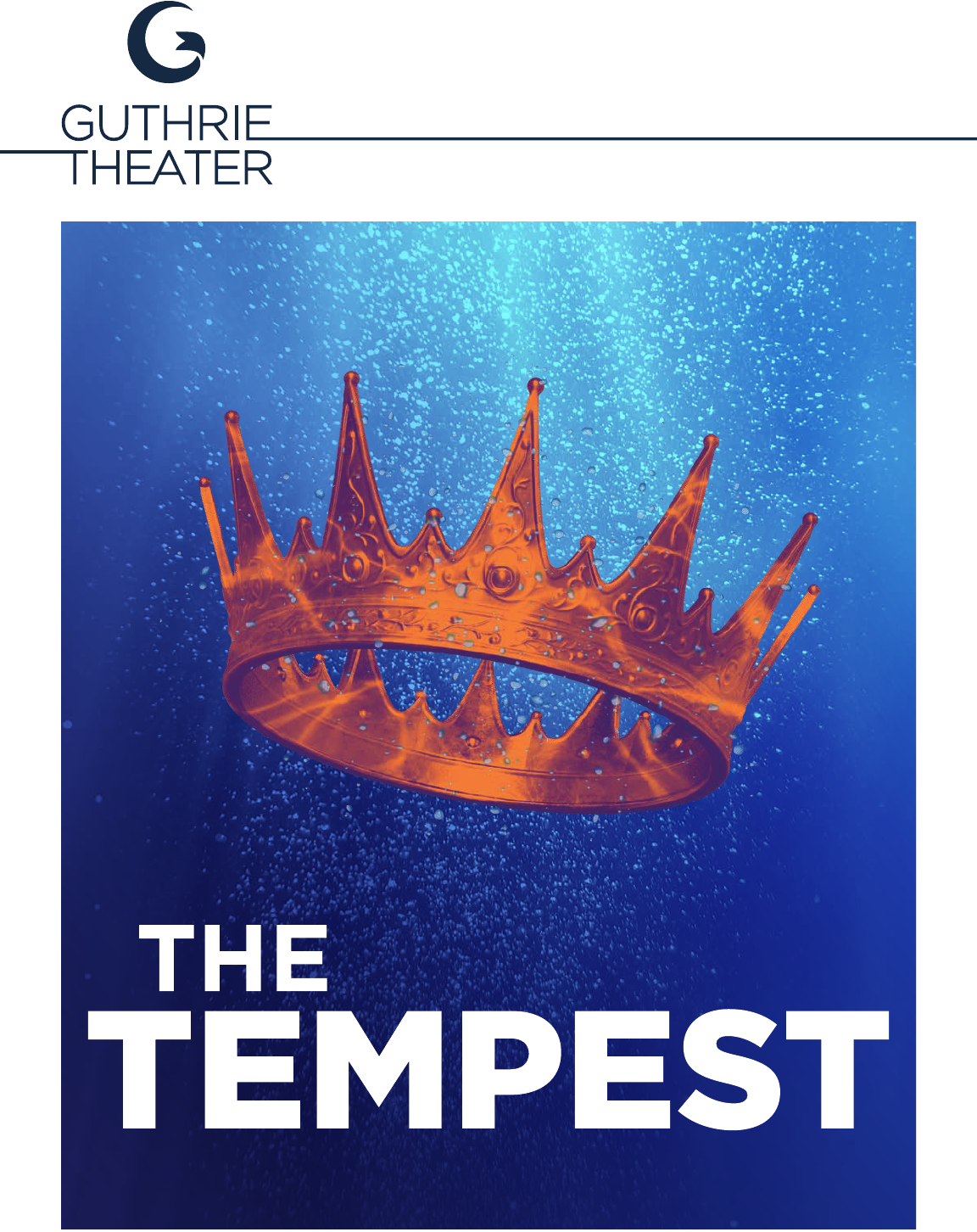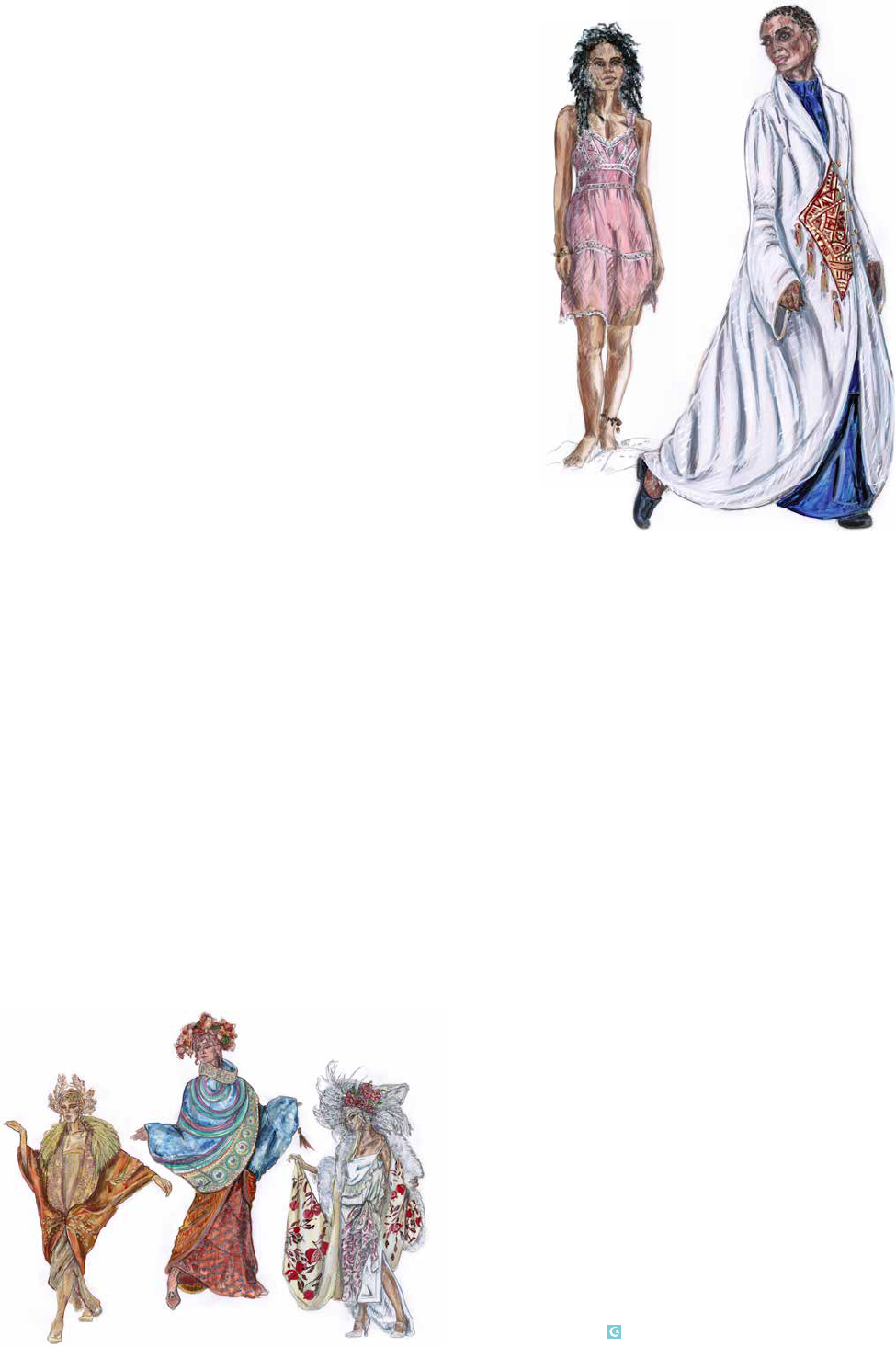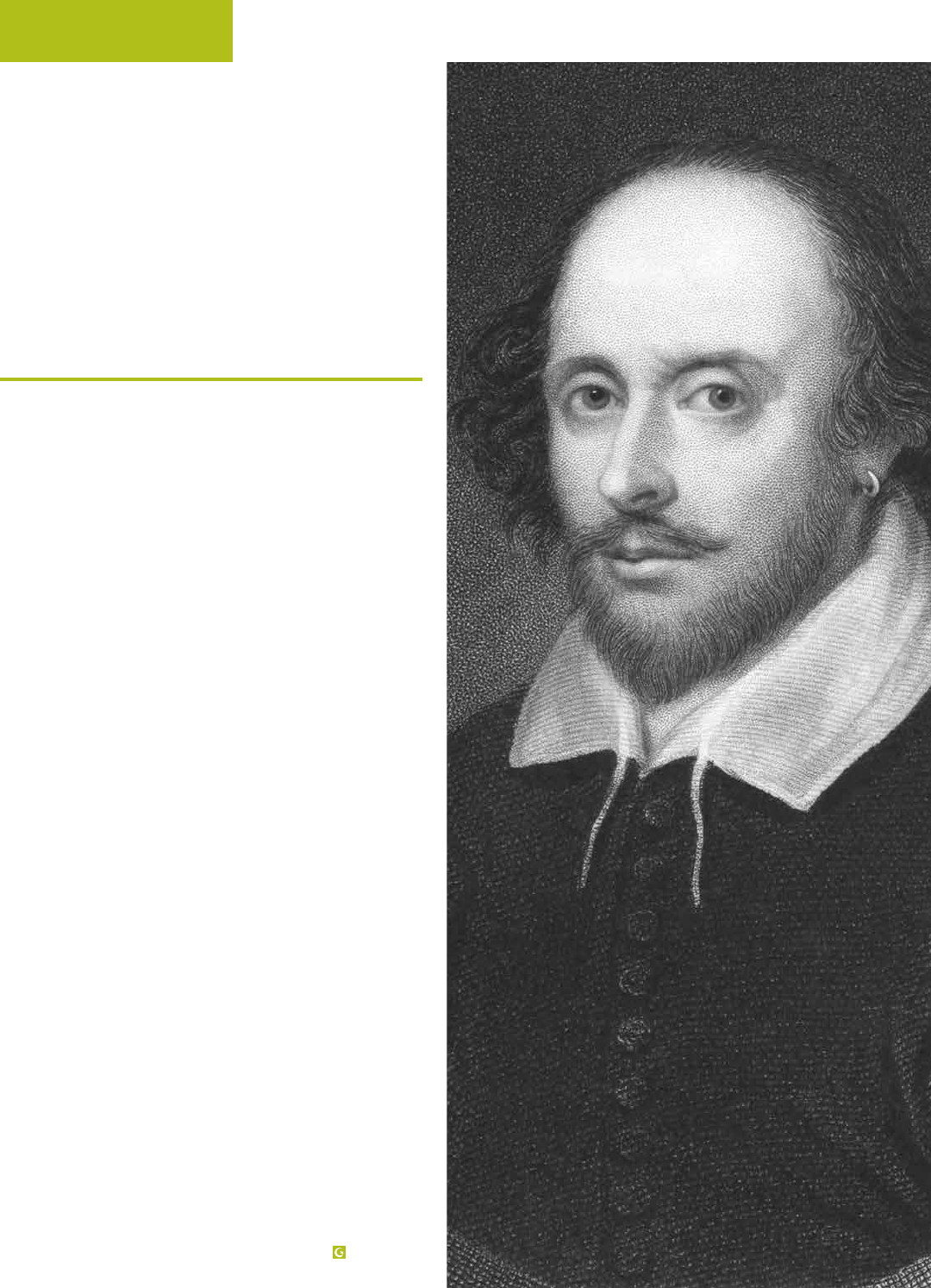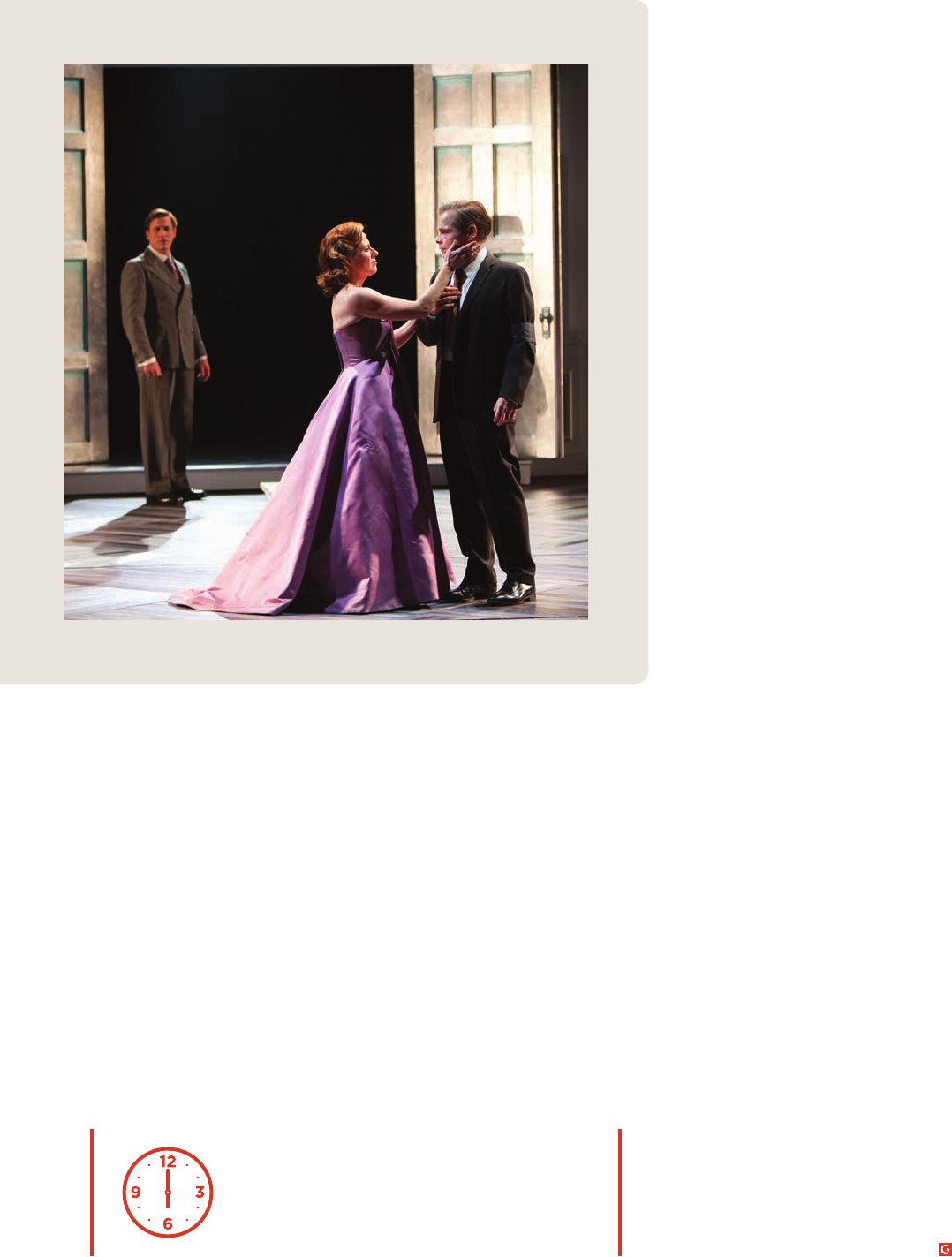
Play Guide
2021–2022 SEASON

Inside
818 South 2nd Street, Minneapolis, MN 55415
ADMINISTRATION 612.225.6000
BOX OFFICE 612.377.2224 or 1.877.447.8243 (toll-free)
guthrietheater.org • Joseph Haj, Artistic Director
The Tempest
by WILLIAM SHAKESPEARE
directed by JOE DOWLING
February 26 – April 16, 2022
Wurtele Thrust Stage
THE PLAY
Synopsis, Setting and Characters • 4
Scene by Scene • 5
Responses to The Tempest • 7
THE PLAYWRIGHT
William Shakespeare • 9
A Legacy That Continues To Inspire • 10
Shakespeare’s Plays • 12
CULTURAL CONTEXT
A Play With Manifold Sources • 13
A Farewell to Arts • 16
Selected Glossary of Terms • 18
EDUCATION RESOURCES
Discussion Questions and Activities • 19
ADDITIONAL INFORMATION
For Further Reading and Understanding • 22
Guthrie Theater Play Guide
Copyright 2022
PRODUCTION DRAMATURG Carla Steen
GRAPHIC DESIGNER Brian Bressler
EDITOR Johanna Buch
CONTRIBUTORS Vanessa Brooke Agnes,
Stephanie Anne Bertumen, Maija García,
Carla Steen
The Guthrie creates transformative theater experiences that ignite the
imagination, stir the heart, open the mind and build community through the
illumination of our common humanity.
All rights reserved. With the exception of classroom use by teachers and individual personal use, no part of this play guide may be reproduced in any form without permission in writing from the
publishers. Some materials are written especially for our guide. Others are reprinted by permission of their publishers.
The Guthrie Theater receives support from the National Endowment for the Arts. This activity is made possible in part by the Minnesota State Arts Board, through an appropriation by the
Minnesota State Legislature. The Minnesota State Arts Board received additional funds to support this activity from the National Endowment for the Arts.
CULTURAL CONTEXT
Source Material • 13
THE PLAY
Synopsis • 4
THE PLAYWRIGHT
William Shakespeare • 9
2 \ GUTHRIE THEATER PLAY GUIDE THE TEMPEST

This play guide is designed to fuel your curiosity and deepen your understanding of a show’s
history, meaning and cultural relevance so you can make the most of your theatergoing
experience. You might be reading this because you fell in love with a show you saw at the
Guthrie. Maybe you want to read up on a play before you see it onstage. Or perhaps you’re a
fellow theater company doing research for an upcoming production. We’re glad you found your
way here, and we encourage you to dig in and mine the depths of this extraordinary story.
NOTE: Sections of this play guide may evolve throughout the run of the show, so check back
often for additional content.
About This Guide
FOR MORE INFORMATION
Thanks for your interest in The Tempest. Please direct literary inquiries to Resident Dramaturg
Carla Steen at carlas@guthrietheater.org.
“The rarer action
is in virtue than
in vengeance.”
– Prospera in The Tempest (Act Five, Scene One)
3 \ GUTHRIE THEATER PLAY GUIDE THE TEMPEST

THE PLAY
Synopsis
Twelve years before the play’s start, Prospera is usurped of her dukedom
of Milan by her brother, Antonio — with the aid of Alonso, the king of
Naples, and his brother, Sebastian — and banished to this island with her
then-3-year-old daughter, Miranda. Prospera has engaged in an intense
study of secret arts, which allows her to thrive on the island, whose only
other inhabitants are the elemental spirit Ariel and a witch’s son Caliban,
both of whom now serve Prospera.
The action of the play begins with Alonso, Antonio and others, including
Alonso’s son, Ferdinand, and an old councilor Gonzala, sailing near
the island. Prospera uses her art to conjure a tempest that strands
her enemies on her island. Under Ariel’s management, the perfectly
unharmed castaways are separated into three groups: Alonso, Antonio
and the rest of the royal court; Ferdinand, alone; and the butler
Stephano and jester Trinculo. The mariners remain onboard asleep.
Although Prospera wants revenge for being usurped, her main goal is to
bring together Ferdinand and Miranda in the hope they will fall in love.
Ferdinand, who thinks his father has died, does indeed fall in love with
Miranda and is immediately put through his paces by Prospera in order
to earn her as his wife, thus securing Miranda’s future.
Likewise, Alonso believes his son is dead, and Antonio suggests to
Sebastian, the king’s brother, that he should kill Alonso and take his
now heirless throne. The attempt is thwarted, but Prospera charges
Ariel to torment them for their past misdeeds. Elsewhere on the island,
Stephano and Trinculo have drunken interactions with Caliban, who
happily pledges allegiance to Stephano if the butler will kill Prospera.
Prospera devises to bring all the parties together at her cell, reuniting
Ferdinand and Alonso, confirming the marriage of Ferdinand and
Miranda, privately calling out Sebastian and Antonio, getting her
dukedom back, sidestepping Caliban’s murder plot and granting Ariel’s
long-promised freedom. After a night of rest, everyone plans to leave
the island for Naples. Prospera promises to break her sta and drown
her spell book, renouncing magic altogether.
In an epilogue, Prospera addresses the audience, asking for their
applause to release her from the island.
PHOTO: REGINA MARIE WILLIAMS AND TYLER MICHAELS KING (DAN NORMAN)
SETTING
On a yacht, then an
uninhabited island in the
Mediterranean Sea.
CHARACTERS
Prospera, rightful duke of Milan
Miranda, her daughter
Ariel, an airy spirit
Caliban, an enslaved man
Ceres, a goddess
Juno, a goddess
Iris, a goddess
Spirits and Hounds
Ariel’s Musician
Alonso, king of Naples
Ferdinand, his son
Sebastian, Alonso’s brother
Antonio, Prospera’s brother
Gonzala, a councilor
Adrian, a courtier
Francisca, a courtier
Stephano, Alonso’s butler
Trinculo, Alonso’s jester
Captain
Boatswain
Mariners
Spirits, Hounds
4 \ GUTHRIE THEATER PLAY GUIDE THE TEMPEST

Scene by Scene
THE PLAY
ACT ONE
Scene One
On a ship, the Captain and Boatswain try to get
a ship (carrying Alonso, the king of Naples, and
his royal court) under control in the midst of a
raging storm.
Scene Two
On a nearby island, Miranda frets over the ship, but
her mother, Prospera, reassures her that no one
was injured and tells her the story of their exile to
this island. Prospera was deposed by her brother,
Antonio, when Miranda was a small child. The sprite
Ariel relates to Prospera how the storm played out
and where everyone on the ship is now. They note
the time and that Ariel’s freedom is soon to come.
Ariel has served Prospera since she freed him from a
tree in which the witch Sycorax had imprisoned him.
Syrcorax was the mother of the only other inhabitant
of the island, Caliban. Alonso’s son, Ferdinand, is led
in by Ariel and mourns his drowned father. Miranda
and Ferdinand are smitten with each other. To test
his devotion, Prospera charms Ferdinand and leads
him o to imprison him.
ACT TWO
Scene One
As councilor Gonzala tries to keep Alonso’s spirits up
(because he fears Ferdinand has drowned), Antonio
and Alonso’s brother, Sebastian, mock her. Gonzala
notes it’s odd that their clothes are as fresh as when
they left Tunis. Ariel puts everyone to sleep with music
except Alonso, Sebastian and Antonio, who encourage
the king to sleep while they keep watch. As Alonso
sleeps, they plot his assassination so Sebastian can
take the crown. Just as they plan to strike, Ariel wakes
the sleepers up, so the conspirators feign hearing an
animal. They all leave to keep looking for Ferdinand.
Scene Two
Caliban gathers wood for Prospera when he hides,
mistaking Trinculo (Alonso’s jester) for a spirit. Trinculo
wonders at Caliban but takes refuge from the storm
under Caliban’s cloak. Alonso’s butler Stephano comes
in singing and sees a four-legged creature (Trinculo
and Caliban under the same cloak). Stephano shares
his wine with Caliban and is reunited with Trinculo.
Caliban is impressed by Stephano — and the alcohol —
and takes him for a god and promises to serve him.
IMAGE: SET DESIGN BY ALEXANDER DODGE
5 \ GUTHRIE THEATER PLAY GUIDE THE TEMPEST

ACT THREE
Scene One
Ferdinand hauls wood until Miranda takes over for him
so he can rest. They talk, reveal they’re in love with
each other and agree to marry. Prospera, observing
from afar, is satisfied.
Scene Two
Stephano, Trinculo and Caliban are drunk. Ariel enters
and mimics Trinculo’s voice, making the others mad at
him for contradicting them. Caliban pleads his case to
Stephano, saying that Prospera’s nap is a good time
to kill her, take over the island and claim Miranda as
queen. Ariel plays music and they follow it.
Scene Three
The king’s group is still wandering the island, with
Sebastian and Antonio planning to strike that night
when everyone is exhausted. Shapes bring in a
banquet, and they debate whether it’s safe to eat. Ariel,
disguised as a Harpy, takes it away just as they decide
to eat and accuses the three of wronging Prospera.
Alonso, Antonio and Sebastian run away aghast.
ACT FOUR
Scene One
Ferdinand and Miranda are betrothed, but they must
wait until a full ceremony to act on their passion,
upon pain of a curse. Ariel reports on the others, and
Prospera tells him to bring them all to her. Meanwhile,
Prospera blesses Miranda and Ferdinand with an
entertainment by Iris, Juno and Ceres, plus nymphs
and reapers. The shapes disappear when Prospera
remembers Caliban’s conspiracy and tells Ariel to get
clothes to attract the three others to her cell — a plan
that succeeds, and Trinculo and Stephano put on the
clothes. Caliban frets that they are missing their window
to act against Prospera. Spirits as hounds chase them
o while Prospera attends to other business.
ACT FIVE
Scene One
The time has come for Prospera’s plan to be fulfilled.
Ariel says he has sympathy for the king and the rest of
his party, and Prospera says perhaps she should, too,
and gives up her quest for revenge. Prospera draws
a circle, renounces magic and Ariel brings in Alonso
and his party, still foggy from the charms. Prospera
changes into her ducal robes, sends Ariel to fetch the
Captain and Boatswain and then presents herself to
Alonso’s group, who finally recognize her and have
many questions about how she arrived on the island.
Alonso restores her dukedom, and Prospera tells
Sebastian and Antonio she knows they’re traitors but
will keep the secret for now. She sympathizes with
Alonso’s loss of a child before revealing Ferdinand and
Miranda playing chess. There is much happiness in the
reunion, and Miranda is overawed at so many people.
Their marriage is revealed and approved by Alonso.
The Captain and Boatswain report that the ship is
undamaged and are amazed that everyone is alive.
Caliban, Trinculo and Stephano come in drunk and
stinky. Caliban is sent to Prospera’s house to prepare it
for guests while Prospera promises to tell her full story
and provide calm seas so the king’s ship can catch
up with the rest of the fleet. She intends to return to
Milan. Ariel is free.
Epilogue
Prospera asks the audience to help return her to Naples
and release her from the island — and theater — via
their applause.
IMAGES: COSTUME DESIGN BY ANN HOULD-WARD
Ceres, Iris and Juno
Miranda and
Prospera
6 \ GUTHRIE THEATER PLAY GUIDE THE TEMPEST

Responses to The Tempest
THE PLAY
EDITOR’S NOTE: The comments below refer to Prospero (he/him), as the character was written by Shakespeare
to be male. This Guthrie production has changed the genders of Prospero, Gonzalo and Francisco to be female
characters named Prospera, Gonzala and Francisca.
Critics have frequently identified Prospero’s art as
theurgy [control over supernatural power] and often
related it to neoplatonic theories of magic. The
intellectual quality of his magic, his command over
Ariel (who is clearly daemon, not demon), his concern
for astrological guidance, and his use of music in his
magic have all been cited to prove his theurgistic and
neoplatonic associations. …
The magical contest between Prospero and Sycorax
is presented with great care, even though it is
narrated by Prospero and Ariel and not witnessed
by the audience. … In The Tempest, as in most plays
involving magical competition, the triumph of a given
side proves its moral superiority to the magic of the
loser, thereby justifying the winner’s magic. After all,
only Prospero’s more powerful “good” magic can
counteract the “bad” magic of Sycorax. Shakespeare
clearly included this account of Prospero’s indirect
competition with Sycorax to strengthen Prospero’s
credentials as a “good” magician. …
Shakespeare carefully depicted the relationship
between Ariel and Prospero. Prospero never conjures
or ritually summons Ariel onstage; all his bonds of
control over the spirit were forged before the play
began; onstage a simple command brings Ariel to
serve his magician (occasionally with some protest).
… A beautifully particularized representative of a long
line of spirits who serve magicians, Ariel provides
spectacle, proof of Prospero’s power, and helps
explain how the play’s magic is performed. Prospero
alone is not capable, if he is human, of raising a
tempest or of making unearthly music. Only by gaining
control of the spirits who manage the functioning
of the natural world can a man accomplish what
Prospero does; Ariel is a necessary intermediary. As
such, he leaves Prospero’s humanity intact.
Barbara Howard Traister
“Prospero: Master of Self-Knowledge,” Heavenly Necromancers:
The Magician in English Renaissance Drama, 1984
[T]he nature of the magic in The Tempest has received a good
deal of critical attention and persuasive explication.
The Tempest is a mirror in which, if we hold it very still, we can gaze backward at all of
[Shakespeare’s] recent plays; and behind them will be glimpses of a past as old as the tragedies,
the middle comedies and even A Midsummer Night's Dream. ... The play seems to order itself in
terms of its meanings; things in it stand for other things, so that we are tempted to search its
dark backward for a single meaning, quite final for Shakespeare and quite abstract. The trouble
is that the meanings are not self-evident. One interpretation of The Tempest does not agree
with another. And there is deeper trouble in the truth that any interpretation, even the wildest, is
more or less plausible. This deep trouble, and this deep truth, should warn us that The Tempest
is a composition about which we had better not be too knowing.
Mark Van Doren
Shakespeare, 1939
7 \ GUTHRIE THEATER PLAY GUIDE THE TEMPEST

Shakespeare’s plays are still worth our attention
because they body forth so brilliantly the virulent
and interesting disease called Western culture.
Racism, imperial domination, anti-Semitism, sexist
craziness and the phallic code of war are not
incidental to that culture. They have been intrinsic
parts of it, and Shakespeare gives us a wonderful
map of the metaphorical system by which that
culture enforces itself. ...
I don’t mean to argue for a Shakespeare who was
a feminist, or a Marxist. Shakespeare was obviously
interested in order, hierarchy and patriarchy. But he
was also a connoisseur of disorder, civil war, family
strife, madness and rebellion. The spark of dramatic
interest always lies in his perception of flaws,
tensions and anomalies in the dominant ideology. He
exploits these cracks, expressing problems covered
over by the apparent social consensus.
Charles Sugnet
“Shakespeare Without Guts,” In Our Times, December 23, 1981 –
January 12, 1982
The Tempest, A Midsummer Night’s Dream and
The Merry Wives of Windsor, which was written
for a command performance, are the only plays of
Shakespeare with an original pot. The Tempest is
also his only play observing the unities of time, place,
and action — which accounts for Prospero’s long,
expository narrative at the beginning of the play
instead of action. …
The Tempest ends, like the other plays in
Shakespeare’s last period, in reconciliation and
forgiveness. But the ending in The Tempest is grimmer,
and the sky is darker than in The Winter’s Tale,
Pericles and Cymbeline. Everybody in the earlier plays
asks forgiveness and gets it, but Prospero, Miranda,
Ferdinand, Gonzalo and Alonso are the only ones
really in the magic circle of The Tempest. Alonso is
forgiven because he asks to be. He is the least guilty,
and he suers most. … Neither Antonio nor Sebastian
say a word to Prospero — their only words after the
reconciliation are mockery at Trinculo, Stephano and
Caliban. They’re spared punishment, but they can’t
be said to be forgiven because they don’t want to
be, and Prospero’s forgiveness of them means only
that he does not take revenge upon them. Caliban is
pardoned conditionally, and he, Stephano and Trinculo
can’t be said to be repentant. They realize only that
they’re on the wrong side, and admit they are fools,
not that they are wrong.
W. H. Auden
Lectures on Shakespeare, 2000
These readings very much depend on one’s
conception of European man’s place in
the universe, and on whether a figure like
Prospero stands for all mankind or for one
side of a conflict.
The first interpretation, following upon the
ideas of Renaissance humanism and the
place of the artist/playwright/magician,
oers a story of mankind at the center
of the universe, of “man” as creator and
authority. … Prospero has often been seen
as a figure for the artist as creator — as
Shakespeare’s stand-in, so to speak, or
Shakespeare’s self-conception, an artist
figure unifying the world around him by his
“so potent art.” … Prospero’s magic books
enable him as well to thwart the incipient
revolts of both high and low conspirators,
and to exact a species of revenge against
those who usurped his dukedom and set
him adrift on the sea — for The Tempest
is one of Shakespeare’s most compelling
“revenge tragedies,” turned, at the last
moment, toward forgiveness. …
The second kind of interpretation, the
colonial or postcolonial narrative, follows
upon early modern voyages of exploration
and discovery, “first contact,” and the
encounters with, and exploitation of,
indigenous peoples in the New World. In
this interpretive context The Tempest is not
idealizing, aesthetic, and “timeless,” but
rather topical, contextual, “political,” and in
dialogue with the times. Yet manifestly this
dichotomy will break down, both in literary
analysis and in performance. It is perfectly
possible for a play about a mage, artist, and
father to be, at the same time, a play about
a colonial governor, since Prospero himself
is, or was, the Duke of Milan.
Marjorie Garber
Shakespeare After All, 2008
Shakespeare’s powerful late
romance The Tempest has been
addressed by modern critics from
two important perspectives: as a
fable of art and creation, and as a
colonialist allegory.
8 \ GUTHRIE THEATER PLAY GUIDE THE TEMPEST

PLAY FEATURETHE PLAYWRIGHT
William
Shakespeare
William Shakespeare was born in 1564 to John
and Mary Arden Shakespeare and raised in
Stratford-upon-Avon, Warwickshire, in England’s
West Country.
Much of the information about him comes from
ocial documents such as wills, legal documents
and court records. There are also contemporary
references to him and his writing. While much of the
biographical information is sketchy and incomplete,
for a person of his class and as the son of a town
alderman, quite a lot of information is available.
Young Shakespeare would have attended the
Stratford grammar school, where he would have
learned to read and write not only English, but
also Latin and some Greek. In 1582, at age 18,
Shakespeare married Anne Hathaway, and the
couple had three children: Susanna in 1583 and
twins Hamnet and Judith in 1585.
After an eight-year gap where Shakespeare’s
activity is not known, he appeared in London by
1592 and quickly began to make a name for himself
as a prolific playwright. He stayed in London for
about 20 years, becoming increasingly successful
in his work as an actor, writer and shareholder in
his acting company. Retirement took him back to
Stratford to lead the life of a country gentleman.
His son Hamnet died at age 11, but both daughters
were married: Susanna to Dr. John Hall and Judith
to Thomas Quiney.
Shakespeare died in Stratford in 1616 on April 23,
which is thought to be his birthday. He is buried in
the parish church, where his grave can be seen to
this day. His known body of work includes at least
37 plays, two long poems and 154 sonnets.
9 \ GUTHRIE THEATER PLAY GUIDE THE TEMPEST

PLAY FEATURETHE PLAYWRIGHT
A Legacy That
Continues To Inspire
The Poetry of Shakespeare was
Inspiration indeed: he is not so
much an Imitator as an Instrument
of Nature; and ’tis not so just to
say that he speaks from her, as
that she speaks through him.
Alexander Pope
Preface to The Works of Shakespeare, 1725
We do not understand Shakespeare
from a single reading, and certainly
not from a single play. There is a
relation between the various plays of
Shakespeare, taken in order; and it
is work of years to venture even one
individual interpretation of the pattern
in Shakespeare’s carpet.
T.S. Eliot
“Dante,” Selected Essays, Faber & Faber, 1929
If one takes those thirty-seven plays with all the radar lines of the dierent viewpoints
of the dierent characters, one comes out with a field of incredible density and
complexity; and eventually one goes a step further, and one finds that what happened,
what passed through this man called Shakespeare and came into existence on
sheets of paper, is something quite dierent from any other author’s work. It’s not
Shakespeare’s view of the world, it’s something which actually resembles reality. A sign
of this is that any single word, line, character or event has not only a large number of
interpretations, but an unlimited number. Which is the characteristic of reality. … An
artist may try to capture and reflect your action, but actually he interprets it — so that
a naturalistic painting, a Picasso painting, a photograph, are all interpretations. But in
itself, the action of one man touching his head is open to unlimited understanding and
interpretation. In reality, that is. What Shakespeare wrote carries that characteristic.
What he wrote is not interpretations: it is the thing itself.
Peter Brook
“What is Shakespeare?” (1947), in The Shifting Point, Harper & Row, 1987
10 \ GUTHRIE THEATER PLAY GUIDE THE TEMPEST

[A]lthough each play is a separate and individual
work of art, they all generally illuminate one
another, and taken together they form an
impressive achievement in which each individual
play acquires more weight and dignity when
placed against the background of the whole
corpus. Each play is more or less a landmark
in the road along which Shakespeare the artist
traveled, or, to change the metaphor, each play is
a variation on a number of themes that recur in
the poet’s work.
M.M. Badawn
Background to Shakespeare, Macmillian India Limited, 1981
Shakespeare’s mind is the type
of the androgynous, of the man-
woman mind. … It is fatal for
anyone who writes to think of their
sex. It is fatal to be a man or a
woman pure and simple; one must
be woman-manly or man-womanly.
Virginia Woolf
A Room of One’s Own, 1929
His characters are intimately bound
up with the audience. That is why
his plays are the greatest example
there is of a people’s theater; in
this theater the public found and
still finds its own problems and
re-experiences them.
Jean-Paul Sartre
On Theater, 1959
Every age creates its own Shakespeare. … Like a portrait whose
eyes seem to follow you around the room, engaging your glance
from every angle, [his] plays and their characters seem always
to be “modern,” always to be “us.”
Marjorie Garber
Shakespeare After All, Anchor Books, 2004
11 \ GUTHRIE THEATER PLAY GUIDE THE TEMPEST

PLAY FEATURETHE PLAYWRIGHT
Shakespeare’s Plays
EARLY PERIOD
ca – The Two Gentlemen of Verona
ca – Titus Andronicus
ca Henry IV, Part II
ca – Henry IV, Part III
ca The Taming of the Shrew
ca Henry IV, Part I Richard III
ca The Comedy of Errors Love’s Labour’s Lost
MIDDLE PERIOD
ca Richard II Romeo and Juliet
ca A Midsummer Night’s Dream King John
The Merchant of Venice
ca Henry IV, Part I Henry IV, Part II
Much Ado About Nothing
ca Henry V Julius Caesar
ca As You Like It The Merry Wives of Windsor
ca Twelfth Night
ca Troilus and Cressida
ca – Hamlet
ca Othello Measure for Measure
ca – All’s Well That Ends Well King Lear Macbeth
LATE PERIOD
ca Timon of Athens Antony and Cleopatra
ca Pericles Coriolanus
ca – The Winter’s Tale
ca Cymbeline
ca The Tempest
ca Henry VIII
ca – The Two Noble Kinsmen
Authorship and dating of Shakespeare’s plays is a subject of much academic
debate. These dates are speculative, but are the “most probable” dating from
The New Oxford Shakespeare: The Complete Works.
THE TEMPEST
The Tempest was written around 1611
and may have premiered by the end
of that year at the Palace of Whitehall
before James I. Public performances
were given at the indoor Blackfriars
Theatre. Along with Pericles, Cymbeline
and The Winter’s Tale, it is one of
Shakespeare’s late plays, sometimes
called romances, which mix elements of
tragedy and comedy. While The Tempest
isn’t his absolutely final play, it’s late
enough in his body of work that many
people have often considered it to be
Shakespeare’s farewell to the stage.
The Tempest stands out in the
Shakespeare canon for a number of
reasons. Its action occurs over the
course of a few hours and in one
location, making it one of the few
plays by Shakespeare that align with
the classical unities of time, place
and action. The plot is mostly original
to Shakespeare and may have been
inspired by contemporary shipwrecks
among early colonial expeditions to
the Americas and Africa. Prospera — a
puppet master extraordinaire — is one
of the great roles in all of the Bard’s
plays, while Ariel and Caliban provide
depth and richness in their loyalty and
resentment toward Prospera.
THE GUTHRIE HAS PREVIOUSLY PRODUCED THE TEMPEST THREE TIMES:
Directed by Philip Minor Directed by Liviu Ciulei Directed by Jennifer Tipton
PHOTO: RICHARD S. IGLEWSKI (MICHAL DANIEL)PHOTO: BRUCE GOLDSTEINPHOTO: PAUL BALLANTYNE AND CHARLES KEATING (FILE PHOTO)
12 \ GUTHRIE THEATER PLAY GUIDE THE TEMPEST

PLAY FEATURECULTURAL CONTEXT
A Play With Manifold Sources
While the plot of The Tempest is mostly original to Shakespeare, he drew on
several influences both old and contemporary to create his tale. There were
scenarios circulating in Italian commedia dell’arte with storylines very much
like that of The Tempest, and European exploration of the Americas led to
inevitable notable shipwrecks.
In 1609, nine ships headed to Jamestown, Virginia, were caught in a storm near Bermuda, during
which the flagship got separated and was assumed lost. But the people on board made it ashore
in the Bermudas, built two small boats and showed up in Jamestown a year later. Among the
other ideas that fueled the creation of The Tempest were a speech in Ovid’s Metamorphoses, an
essay by Montaigne and courtly entertainments called masques.
13 \ GUTHRIE THEATER PLAY GUIDE THE TEMPEST

OVID’S METAMORPHOSES
Prospera’s Act Five speech, in which she renounces magic, is often considered an almost direct borrowing by
Shakespeare from a speech delivered by Medea in Ovid’s story about her marriage to the hero Jason in a 1567
translation by Arthur Golding. For comparison, we placed the speeches side by side and noted the similarities.
NOTE: Before this speech, Jason has arrived in Medea’s homeland of Colchis to collect the Golden Fleece.
Medea’s father, the king, sets up feats for Jason to accomplish and, with her magic, Medea — passionately in love
with Jason — helps Jason successfully complete them and get the Fleece. When they return to Jason’s land of
Iolchus, he asks Medea to take years from his life and give them to his aged father, Aeson. Medea says she can’t
do that, but she’ll ask Hecate for aid in extending Aeson’s life.
MEDEA
Upon the bare, hard ground she said, “O trusty time of night
Most faithful unto privities, O golden stars whose light
Doth jointly with the moon succeed the beams that blaze
by day,
And thou three-headed Hecate, who knowest best the way
To compass this our great attempt and art our chiefest stay;
Ye Charms and Witchcrafts, and thou Earth, which both with
herb and weed
Of mighty working furnishest the Wizards at their need;
Ye Airs and winds; ye Elves of Hills, of Brooks, of Woods alone,
Of standing Lakes, and of the Night, approach ye every one,
Through help of whom (the crooked banks much wond’ring
at the thing)
I have compelled streams to run clean backward to their
spring.
By charms I make the calm seas rough and make the rough
seas plain,
And cover all the sky with clouds and chase them thence
again.
By charms I raise and lay the winds and burst the Viper’s jaw,
And from the bowels of the earth both stones and trees do
draw.
Whole woods and Forests I remove; I make the Mountains
shake,
And even the Earth itself to groan and fearfully to quake.
I call up dead men from their graves; and thee, O lightsome
Moon,
I darken oft, though beaten brass abate thy peril soon;
Our Sorcery dims the Morning fair and darks the Sun at Noon.
...
Now have I need of herbs that can by virtue of their juice
To flowering prime of lusty youth old withered age reduce.
I am assured ye will it grant; for not in vain have shone
These twinkling stars, ne yet in vain this chariot all alone
By draught of dragons hither comes.” With that was from
the sky
A chariot softly glanced down, and stayed hard thereby.
PROSPERA
You elves of hills, brooks, standing lakes,
and groves,
And you that on the sands with printless foot
Do chase the ebbing Neptune, and do fly him
When he comes back; you demi-puppets that
By moonshine do the green sour ringlets
make,
Whereof the ewe not bites; and you whose
pastime
Is to make midnight mushrumps, that rejoice
To hear the solemn curfew; by whose aid,
Weak masters though you be, I have
bedimmed
The noontide sun, called forth the mutinous
winds,
And ’twixt the green sea and the azured vault
Set roaring war; to the dread rattling thunder
Have I given fire, and rifted Jove’s stout oak
With his own bolt; the strong-based
promontory
Have I made shake, and by the spurs plucked
up
The pine and cedar; graves at my command
Have waked their sleepers, oped, and let ’em
forth
By my so potent art. But this rough magic
I here abjure, and when I have required
Some heavenly music, which even now I do,
To work mine end upon their senses that
This airy charm is for, I’ll break my sta,
Bury it certain fathoms in the earth,
And deeper than did ever plummet sound
I’ll drown my book.
METAMORPHOSES THE TEMPEST
14 \ GUTHRIE THEATER PLAY GUIDE THE TEMPEST

COURT MASQUES
A specific entertainment that hit its zenith in England during the Stuart monarchies, the court masque is the
basis for the “vanity of mine art” that Prospera creates to celebrate the engagement of Miranda to Ferdinand in
Act Four. Prospera instructs Ariel to bring other spirits, who then take the form of the goddesses Iris, Juno and
Ceres to bless the couple. The spectacle ends in a lively dance complete with nymphs and reapers. (The Tempest
was performed at court to honor the marriage of James I’s daughter Elizabeth during the winter of 1611–1612.)
The masque could encompass many forms — theater, pageants or processions. No matter the form or style,
what bound them together was the celebration and glorification of the monarch or a member of the nobility.
The Tudors (James I and Charles I) tended to favor theatrical masques, which could include music and three
dances, with the dancers often being members of the court. Professional musicians and actors also performed in
masques, which led to the introduction of masque-like elements into theater troupes’ non-court work. Featuring
mythological, classical or even allegorical characters, masques almost always put spectacle at the center, resulting
in enormously expensive productions with elaborate scenic elements. In 1618, James I spent more on one masque
than he had spent collectively on all professional theater troupes’ plays during the whole of his reign.
MICHEL DE MONTAIGNE’S “OF CANNIBALS” ESSAY
In her Act Two speech, Gonzala describes an image of a Golden Age, often thought in classical mythology as the
first age of the world and in biblical terms as a Garden of Eden. The Golden Age was followed by “progressively
degenerate” ages of Silver, Bronze and Lead. The idea of (or returning to) a Golden Age captured minds in dierent
periods, and at the time of Shakespeare’s writing, Native Americans were often seen by Europeans as innocents of
a Golden Age. Gonzala’s ideas align with parts of Montaigne’s “Of Cannibals,” an essay available to Shakespeare via
John Florio’s 1603 translation. For comparison, we placed the texts side by side and noted the similarities.
MONTAIGNE
These nations then seem to me to be so far barbarous, as
having received but very little form and fashion from art and
human invention, and consequently to be not much remote
from their original simplicity. The laws of nature, however,
govern them still, not as yet much vitiated with any mixture of
ours: but ‘tis in such purity, that I am sometimes troubled we
were not sooner acquainted with these people, and that they
were not discovered in those better times, when there were
men much more able to judge of them than we are. I am sorry
that Lycurgus and Plato had no knowledge of them; for to my
apprehension, what we now see in those nations, does not only
surpass all the pictures with which the poets have adorned the
golden age, and all their inventions in feigning a happy state
of man, but, moreover, the fancy and even the wish and desire
of philosophy itself; so native and so pure a simplicity, as we
by experience see to be in them, could never enter into their
imagination, nor could they ever believe that human society
could have been maintained with so little artifice and human
patchwork. I should tell Plato that it is a nation wherein there
is no manner of trac, no knowledge of letters, no science of
numbers, no name of magistrate or political superiority; no
use of service, riches or poverty, no contracts, no successions,
no dividends, no properties, no employments, but those of
leisure, no respect of kindred, but common, no clothing, no
agriculture, no metal, no use of corn or wine; the very words
that signify lying, treachery, dissimulation, avarice, envy,
detraction, pardon, never heard of.
GONZALA
Had I plantation of this isle, my lord —
— And were the king on’t, what would I do?
I’th’commonwealth I would by contraries
Execute all things, for no kind of trac
Would I admit; no name of magistrate;
Letters should not be known; riches, poverty,
And use of service, none; contract, succession,
Bourn, bound of land, tilth, vineyard, none;
No use of metal, corn, or wine, or oil;
No occupation; all men idle, all,
And women too, but innocent and pure;
No sovereignty —
All things in common nature should produce
Without sweat or endeavor. Treason, felony,
Sword, pike, knife, gun, or need of any engine
Would I not have; but nature should bring forth
Of its own kind all foison, all abundance,
To feed my innocent people.
I would with such perfection govern, sir,
T’excel the Golden Age.
“OF CANNIBALS” THE TEMPEST
15 \ GUTHRIE THEATER PLAY GUIDE THE TEMPEST

A Farewell
to Arts
PHOTO: JENNY GRAHAM
Four of his last plays — Pericles,
Cymbeline, The Winter’s Tale
and The Tempest — are often
grouped under an umbrella genre
called romance or tragi-comedy.
As the latter label suggests, the
plays contain features of tragedy
(mistakes, crimes, disasters) and
comedy (abundance of humor,
marriage, happy endings). The
label romance, however, better
hints at the adventure these plays
oer: shipwrecks, faked deaths,
time jumps, magic, long-lost
children, deity cameos and more.
Shakespeare didn’t invent the
romance; it was merely a new
fashion in the theater built on an
old story form that he adopted
and, as with much that he touched,
improved on. Perhaps he was bored
playing by the rules of history,
comedy and tragedy and leaped
at the chance to mix it up and take
on a new challenge. In discussing
The Winter’s Tale, actor-director-
critic Harley Granville-Barker
called it “essentially the product of
middle age. … The technique of it is
mature, that of a man who knows
he can do what he will.”
One of the most compelling
features of Shakespeare’s
romances is a restored sense of
balance and harmony at the play’s
end in the form of forgiveness and
reconciliation. (One could argue
that tragedies such as Hamlet,
Macbeth and King Lear end in
balance restored, but the cost is
high and usually quite bloody.)
In a romance, a character who
makes a major mistake early in the
play — or before the play begins, in
the case of The Tempest — suers
through trials but receives at least
partial reparation for their troubles
and usually emerges the wiser.
Literary critic Northrop Frye notes
that the romances operate on
a smaller scale; the characters
and ideas may be kindred with
earlier tragedies, but the scope
is dierent. The grandness and
complexity of characters such as
Hamlet or Lear aren’t found in
these plays, and while the plots
may contain jealousy or ambition,
it’s not Othello-level jealousy or
Macbeth-level ambition. Perhaps
it’s their scale that enables
their reconciliations.
While Shakespeare’s four romances
have much in common, they aren’t
cookie-cutter stories, and The
By Carla Steen
Resident Dramaturg
William Shakespeare is
generally thought to have
written his plays between
1589 and 1613. In those 24
years, he created nearly 40
plays, a few in collaboration.
The Tempest is usually
dated to 1611, so it is not
only a mature work, it is a
very late play and likely the
last play he wrote alone.
Scenes From Shakespeare’s Romance Plays
Jennie Greenberry as Marina and Wayne T. Carr as Pericles in the Guthrie’s
2016 production
Pericles
PLAY FEATURECULTURAL CONTEXT
16 \ GUTHRIE THEATER PLAY GUIDE THE TEMPEST

Tempest has some singular features.
For the first time since his early play
The Comedy of Errors, Shakespeare
constructs a play that adheres to
the unities of time, place and action.
The whole of the play unfolds over
just a few afternoon hours and
takes place almost exclusively on
Prospera’s island. And the action
drives toward characters being
reunited and just deserts being
delivered. Where other romances
feature long-lost daughters (Perdita
in The Winter’s Tale, Marina in
Pericles), Miranda is never lost nor
unknown to her parent; rather,
Prospera herself has been thought
lost and is reunited, if ambivalently,
with her brother, Antonio.
Also distinctive about The Tempest
when compared to the body of
Shakespeare’s work — not just
the romances — is that it has
an original plot, joining a small
subgroup of plays that includes
only The Merry Wives of Windsor
and A Midsummer Night’s Dream.
The Tempest may have been
inspired by then-contemporary
shipwrecks among early European
colonial expeditions to the
Americas and Africa. Especially in
recent generations, the themes of
colonialism and the treatment of
Indigenous cultures central to the
play have been brought to the fore
in the design of many productions.
But perhaps the characteristic
of The Tempest that most often
captures the imaginations of
interpreters and audiences alike is
its place so late in Shakespeare’s
career. Did he know this would
be his last solo work for the
stage? It’s almost impossible to
resist imagining that he did; in its
construction can be found a play-
length metaphor for playwriting (or
indeed for any artmaking).
Prospera spends years studying,
developing and then perfecting her
craft of magical arts, which allows
her to become the ruling power
of her island. Having achieved her
goal, she eventually gives up her
art when her own native dukedom
is restored to her. It’s not a stretch
to see in this character a shadow
of Shakespeare himself: He spent
years in his craft, developing and
perfecting his dramatic art and
reaching the pinnacle of theater
on his island. Eventually, having
achieved what he could, he gave
up the theater and returned to his
own native Stratford.
Especially in The Tempest’s
Epilogue, in which Prospera (or
the actor playing her) addresses
the audience directly, does this
playwright’s farewell seem evident.
“But release me from my bands/
With the help of your good hands”
puts the power firmly in the
applause of the audience to free
Prospera from her island and the
actor from the theater.
It also provides a final ovation for a
playwright leaving his profession.
Bill McCallum as Polixenes, Michelle O’Neill as Hermione and Michael Hayden
as Leontes in the Guthrie’s 2011 production
The whole of the play unfolds over just
a few afternoon hours and takes place
almost exclusively on Prospera’s island.
The Winter’s Tale
PHOTO: T CHARLES ERICKSON
Scenes From Shakespeare’s Romance Plays
17 \ GUTHRIE THEATER PLAY GUIDE THE TEMPEST

PLAY FEATURECULTURAL CONTEXT
Selected Glossary of Terms
ague — Fever, sickness
art — Magic, both the learning and
practice of; also, the trickery and
artifice associated with magic
blue-eyed — At a time when grey
or black eyes were the standard in
beauty, blue eyes or blue eyelids
were associated with witches
boatswain — A ship’s ocer in
charge of the crew’s work and the
ship’s equipment, such as sails,
rigging and ropes
brave — Excellent, splendid, fine,
handsome
butt — Barrel, as in a wine cask
Ceres — In Roman mythology, the
goddess of the earth and agriculture
(associated with Demeter in Greek
mythology) and the mother of
Persephone; a Mother Earth figure
charm — Verbal magic; sometimes
a thing imbued with magic. In
Shakespeare, charms are often
connected with music and work
with a natural inclination, such as
sleepiness or remorse.
chess — A board game of strategy
that originated in sixth-century India,
moved to the Middle East and then
to Europe. Because of its popularity
among the nobility, it became known
as the “royal game” or “the game
of kings.” (The English word chess
derives from the Persian word shah,
which means “king.”) Naples was a
center for playing chess.
dolor — Grief, suering
entertainment — Hospitality,
treatment
fathom — Approximately 6 feet;
“full fathom five” is 30 feet
flamed amazement — A terrifying
flash of light. In The Tempest, Ariel
is likely recreating the weather
phenomenon of St. Elmo’s fire,
where static electricity can appear
during certain conditions. It creates
a faint light or glow on the points
of certain objects, such as a ship’s
mast during a storm.
Hagseed — A child (seed) of a
witch (hag)
Iris — In Greek mythology, the
goddess (or personification) of the
rainbow. She was a messenger of
the gods, especially connected to
Juno, and she used the rainbow as
her route of transportation.
Jove — Another name for Jupiter;
in Roman mythology, the chief
god, husband-brother of Juno
and equivalent of Zeus in Greek
mythology. As the lord of heaven
and bringer of light, he was known
for his lightning bolts.
Juno — In Roman mythology, the
queen of the gods (associated
with Hera in Greek mythology),
Ceres’ sister and Jupiter’s wife. She
is associated with marriage and
motherhood.
league — Approximately 3 miles
liberal arts — The seven subjects
of study during the rise of the
medieval university system:
the Trivium (grammar, logic
and rhetoric) and Quadrivium
(arithmetic, geometry, music/
harmonics and astronomy)
man i’th’moon — Tradition has
it that the man in the moon has a
dog and carries a bundle of sticks
picked up on a Sunday.
mooncalf — Calves born with
deformities were believed to be
under the moon’s malign influence.
The term was also used to describe
mentally or physically disabled
people who were thought to
have experienced adverse lunar
influence while in the womb.
Neptune — In Roman mythology,
the god of the sea and Jupiter’s
brother (known as Poseidon in
Greek mythology); sometimes his
name was used for the sea itself.
He was frequently depicted with
his three-pointed trident.
perfidious — Treacherous, disloyal
prince — A sovereign ruler,
sometimes used specifically for a
ruler of a small state, which is then
subject to a king
signories — Territories, specifically
Italian city-states
supplant — Uproot, remove, usurp
trumpery — Fancy garments, or
perhaps worthless finery
Sources include notes to The New Cambridge Shakespeare and The Arden Shakespeare editions of the play; Shakespeare’s Words by David
Crystal and Ben Crystal; Encyclopedia Britannica; Brewer’s Dictionary of Phrase and Fable; Asimov’s Guide to Shakespeare; Shakespeare’s
Demonology: A Dictionary; and Oxford English Dictionary.
18 \ GUTHRIE THEATER PLAY GUIDE THE TEMPEST

PLAY FEATURE
EDUCATION RESOURCES
Discussion Questions
and Activities
THE ROLE OF GENDER IN SHAKESPEARE’S PLAYS
It is common knowledge that during William Shakespeare’s life, his plays were performed by a cast of entirely
male actors. Even female roles were depicted by cisgender men.
“In 16th- and early 17th-century Europe, the prohibition of public acting by women and the
convention of all-male casting were peculiar to England. Though easily accepted by audiences,
the playing of female roles by boys led writers to emphasize the femininity of women in their
plays to an extent that the use of female performers would have rendered unnecessary.”
From The Arden Shakespeare edited by Richard Proudfoot, Ann Thompson and David Scott.
Kastan, 1998. Reprinted, 2000.
In contemporary theater, female roles are generally played by women. In recent years, many female actors have
taken on significant male roles, thus subverting tradition and lending new perspectives to the role of gender in
Shakespeare’s plays.
Discussion Questions
The lead character in The Tempest — Prospero — was written as a man, a father and former duke of Milan. In this
Guthrie production, the role has been changed to Prospera and is played by local actor Regina Marie Williams.
The characters of Gonzalo and Francisco are also played as women (Gonzala and Francisca), while the character
of Trinculo is played as a man by a cisgendered woman.
• What did you notice about the role of gender in Shakespeare’s The Tempest?
• How would you describe the character of Prospero/Prospera? What about this character stands out as being
particularly masculine or feminine?
• Which character in the play did you find most interesting or most complex — and why?
• Do you think Shakespeare’s female characters reflect the same amount of depth or complexity as his male
characters? Do you believe Shakespeare would have written more complex female characters into his plays if
he had been able to cast female or nonbinary actors?
Online Activity: A Letter From the Director
Imagine it is early 17th-century England, and you are the director of The Tempest.
• OPTION ONE: Write a letter to the boy who will be playing Miranda.
• OPTION TWO: Write a letter to the woman who will be playing Prospero, a male character.
Explain what they will need to know in order to portray this character as believably as possible. Feel free to
include any special instructions or advice in your letter.
19 \ GUTHRIE THEATER PLAY GUIDE THE TEMPEST

Classroom Activity: Stepping Into the Role
Besides gender, there are other ways an actor may personally dier from the character they portray onstage. At
times, an actor may be cast as a character whose experiences are rather dissimilar from their own. In such cases,
the actor may need to do a significant amount of research to connect with their character and better understand
their point of view before stepping into the role. The actor may seek out a real-life person who shares some of
the character’s particular life experiences. The actor will listen and ask questions in an eort to see the world
through that person’s eyes.
For this activity, place students in groups of two (or three, if needed). For ease of explanation, the following
instructions refer to Student A and Student B within each group. NOTE: If in a group of three, repeat the
instructions below with Students B and C.
Student A: Think of a specific memory from your life when you were in a natural environment (at a lake, at the
beach, in the woods, at a park). Describe this one experience to Student B in as much detail as possible for 5–7
minutes. It can be any memory you are willing to share and that you can recall in vivid detail.
Student B: Listen for details and take time to write a few notes for yourself to help you remember key aspects
of the story. Ask Student A questions about the environment, people or animals involved or any specifics about
the action. Then put your notes down. As you are able, get on your feet and act out this memory as if you are
reliving it as Student A. Go through the actions, see the sights, hear the sounds and recall the thoughts and
emotions that Student A described in their story. Bring them to life as if they were your own.
Student A: Sit quietly and observe like an audience. This is Student B’s interpretation of your story, and it’s okay
if some aspects are reimagined!
Student B: Try another version of the storytelling where you recreate the experience just physically in space
without using words.
Students A and B: Come together and discuss.
• For Student B: Were any of the thoughts, emotions or experiences familiar to you? Did acting it out make it
feel more familiar than when you were just listening to the story?
• For Student A: What was it like to have a segment of your life played out in front of you?
Discuss the following questions as a group:
• Is it important for you to see someone onstage who reminds you of yourself?
• What does it mean for someone with a very dierent life experience to portray your story?
PHOTO: LAAKAN McHARDY, JOHN KROFT AND REGINA MARIE WILLIAMS (DAN NORMAN) PHOTO: HARRY SMITH (DAN NORMAN)
20 \ GUTHRIE THEATER PLAY GUIDE THE TEMPEST

A WORLD OF HUMANS AND SPIRITS
“Only by gaining control of the spirits who manage the functioning of the
natural world can a man accomplish what Prospero does; Ariel is a necessary
intermediary. As such, he leaves Prospero’s humanity intact.”
From “Prospero: Master of Self-Knowledge” by Barbara Howard Traister. Heavenly
Necromancers: The Magician in English Renaissance Drama, 1984.
Discussion Questions
• How would you describe the role of Ariel in Shakespeare’s The Tempest? What kind of parallels could be made
between Ariel’s magic and the magic of theater?
• How does Prospera embrace her human abilities and limitations? What does she desire most at the beginning of the
play, and how do her priorities change by the end of the play? Would you describe her journey as transformative?
• How much of Caliban’s behavior stems from his resentment toward having been forced into servitude? Where
might you find humanity in the character of Caliban?
• Which character in the play did you care about the most? What made you sympathize with them? At what
point in the play did you feel most concerned about their situation or about what was going to happen next?
Online Activity: Heroes and Villains
The Tempest falls in the genre of romance/tragi-comedy where typical expectations of heroes and villains might be
subverted. For example, if The Tempest played out as the revenge drama it initially appears to be, would Prospera be a
villain? Since she doesn’t take revenge and the play turns toward a happy ending, is Prospera a hero? Given the events
that occurred in Milan 12 years ago, is Antonio a villain? Is there a point of view that is more sympathetic to him? Is the
same true of Sebastian as he plots to murder Alonso on the island? Or are there degrees of villainy and heroism?
Ask students to write freely for 15 minutes based on these prompts: What makes a character a hero? What makes
a character a villain? Does it depend on the point of view from which the story is told? Choose two characters from
the play and write about why you believe each to be a hero or a villain. If there were one action that each character
could take (or do dierently) that would cause you to categorize them as the opposite, what would that action be?
If it is possible for a villain to become a hero, what circumstances are necessary for that chance to take place?
Classroom Activity: Poetry in Shakespeare
Have you ever tried to explain how you were feeling to someone and struggled to find the words? Symbolism,
simile and metaphor can help communicate those big thoughts and feelings! Shakespeare uses poetic language
when everyday language does not suce to convey a particular idea or emotion. For the following activity,
students may work individually and then share their ideas with the class.
The Tempest begins with a pivotal “natural” event — a storm. Shakespeare uses the symbolism of this force of
nature to turn the world upside down for most characters in the play. Invite students to think of a change in
their life that felt significant, and have them draw a picture or write a poem (in any form) that illustrates their
experience of that event using only language that has to do with nature or natural occurrences (thunderstorms,
lightning, blossoming flowers, falling leaves, crashing waves). Students may also choose one emotion (joy,
sorrow, frustration) and draw or write about it using images found in nature.
The play itself is an extended metaphor for an artist’s work. As an expansion of this exercise, ask students to
search the text for expressions of poetry or imagery that point back to the theatrical metaphor.
Discuss the following questions as a group:
• What does it feel like to use poetic language and symbolism from the natural world to describe your
circumstances or experiences?
• What were your impressions of your classmates’ pictures and poems?
• Did you relate to any of their experiences as described? If so, how?
21 \ GUTHRIE THEATER PLAY GUIDE THE TEMPEST

For Further Reading
and Understanding
ADDITIONAL
INFORMATION
EDITIONS OF THE TEMPEST
The Tempest edited by David Lindley. The New Cambridge
Shakespeare.
The Tempest edited by Virginia Mason Vaughan and Alden T.
Vaughan. The Arden Shakespeare.
FILMS
Tempest, adapted by Paul Mazursky and Leon Capetanos, directed
by John Cassavetes. Starring Cassavetes as Phillip, Gena
Rowlands as Antonia, Susan Sarandon as Aretha, Raul Julia as
Kalibanos and Molly Ringwald as Miranda. 1982.
Prospero’s Books, adapted and directed by Peter Greenaway.
Starring John Gielgud as Prospero, Isabelle Pasco as Miranda,
Tom Bell as Antonio and Mark Rylance as Ferdinand. 1991.
The Tempest, directed by Julie Taymor. Starring Helen Mirren as
Prospera, Felicity Jones as Miranda, Djimon Hounsou as Caliban,
Ben Whishaw as Ariel and Chris Cooper as Antonio. 2010.
BOOKS (General Shakespeare Studies)
Asimov’s Guide to Shakespeare (two volumes) by Issac Asimov.
Avenel Books, 1970.
Lectures on Shakespeare by W. H. Auden. Princeton University
Press, 2000.
Shakespeare’s Great Stage of Fools by Robert H. Bell. Palgrave
Macmillan, 2011.
Pronouncing Shakespeare’s Words: A Guide From A to Zounds
by Dale F. Coye. Greenwood Press, 1998.
Shakespeare’s Words: A Glossary and Language Companion
by David and Ben Crystal. Penguin Books, 2002.
Shakespeare’s Songbook by Ross W. Dun. W. W. Norton &
Company, 2004.
Shakespeare After All by Marjorie Garber. Pantheon, 2004.
Prefaces to Shakespeare by Harley Granville-Barker. Princeton
University Press, 1947.
Will in the World: How Shakespeare Became Shakespeare by
Stephen Greenblatt. W. W. Norton & Company, 2004.
Shakespeare’s Motley by Leslie Hotson. Haskell House Publishers,
1971.
Contested Will: Who Wrote Shakespeare? by James Shapiro.
Simon & Schuster, 2001.
Passing Strange: Shakespeare, Race and Contemporary America
by Ayanna Thompson. Oxford University Press, 2011.
WEBSITES
Folger Shakespeare Library. A wealth of resources, including
lesson plans, study guides and interactive activities.
www.folger.edu
Shakespeare Unlimited. A biweekly podcast produced by
the Folger Shakespeare Library that features interviews
with Shakespeare experts on topics ranging from adapting
Shakespeare to what Elizabethans ate to discussions about
current productions.
www.folger.edu/shakespeare-unlimited
Internet Shakespeare Editions. A collection of materials on
Shakespeare and his plays, an extensive archive of productions
and production materials.
http://internetshakespeare.uvic.ca/index.html
Shakespeare Uncovered. A series that goes in-depth into one play
per episode. A host with a personal tie to the play investigates
the text and its interpretations and visits companies in rehearsal
and in performance. Episodes may be available online. The
Tempest was included in the first season hosted by theater
director Trevor Nunn.
www.pbs.org/wnet/shakespeare-uncovered
MIT Shakespeare: The Complete Works Online
http://shakespeare.mit.edu
PlayShakespeare.com: The Ultimate Free Shakespeare Resource.
After registration, receive access to the full texts of the plays,
synopses, the First Folio and study aids. An accompanying
smartphone app features full texts of the plays.
www.playshakespeare.com
PHOTO: STEPHEN YOAKAM WITH BILL McCALLUM (DAN NORMAN)
22 \ GUTHRIE THEATER PLAY GUIDE THE TEMPEST
